Abstract
Previous studies have shown that human sperm that have undergone the acrosome reaction express a unique tissue-specific variant of the complement component 3 (C3)-binding molecule membrane cofactor protein (MCP, CD46) and that damaged or dead sperm activate the alternative pathway of complement and bind C3 catabolites. In this study we provide evidence that MCP on sperm that have undergone the acrosome reaction specifically binds dimeric C3b and that human sperm acrosomal proteases released during the acrosome reaction directly cleave C3, facilitating its binding to MCP. Furthermore, human and hamster oocytes can activate the alternative pathway of complement and also bind human C3 fragments. Monoclonal antibodies specific for complement receptors type 1 (CD35) and type 3 (CD11b/CD18) bind to the human oocyte plasma membrane, indicating that specific complement-binding molecules may play a role in the attachment of C3 catabolites to oocytes. Subsaturating concentrations of dimeric C3b (0.01-1 microM) promoted penetration of hamster oocytes by human sperm, whereas saturating doses (> 10 microM) inhibited this process. In addition, antibodies to both MCP and C3 significantly inhibited penetration of hamster oocytes by human sperm. These data provide evidence that regulated gamete-induced generation of C3 fragments and the binding of these fragments by selectively expressed receptors on sperm and oocytes may be an initial step in gamete interaction, leading to membrane fusion and fertilization.
Full text
PDF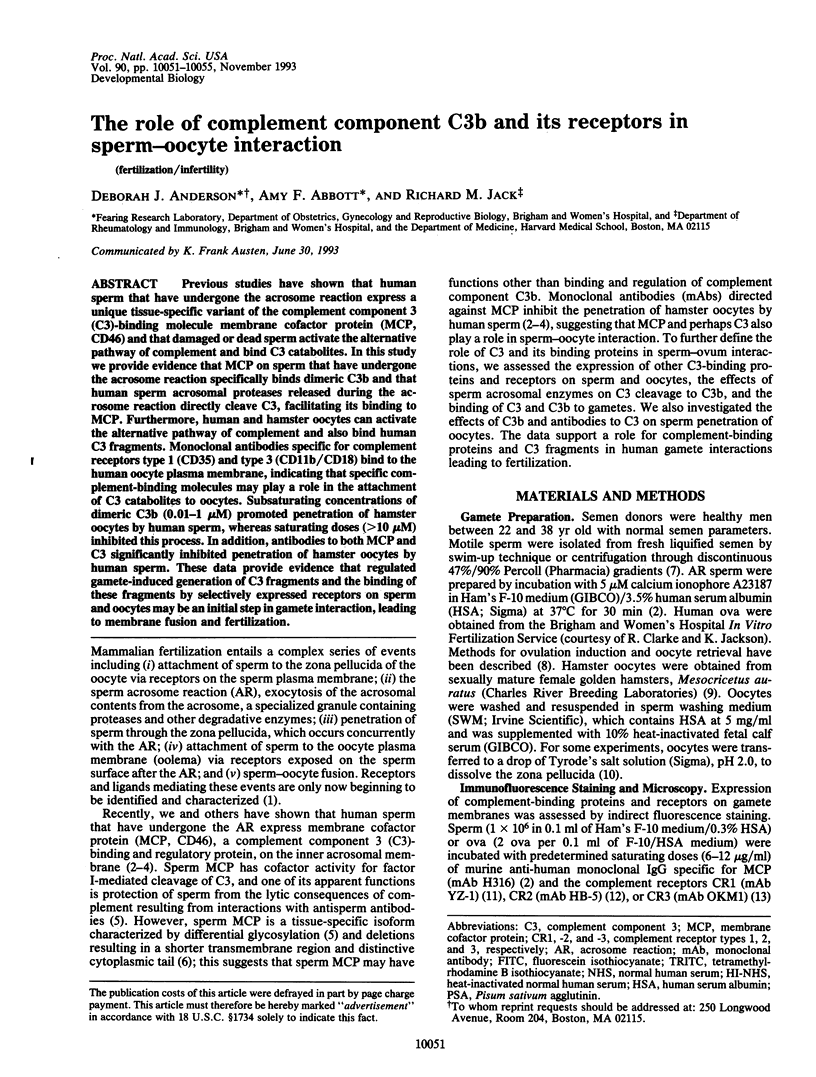
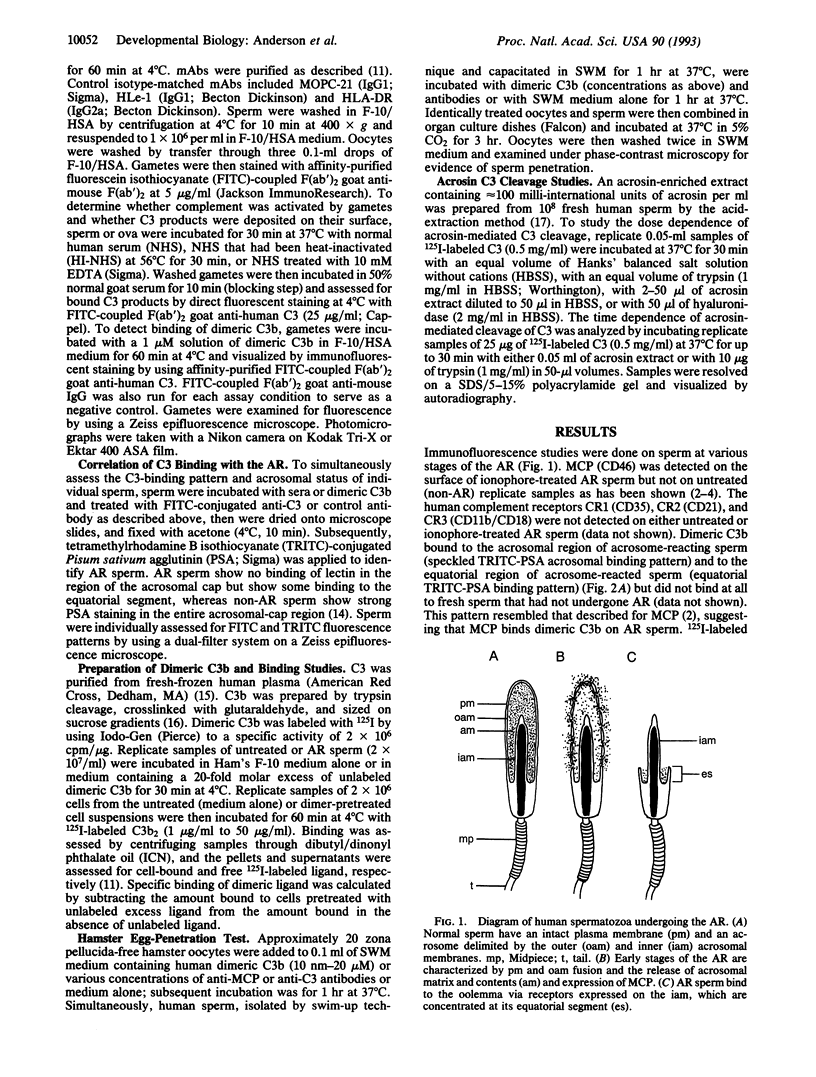
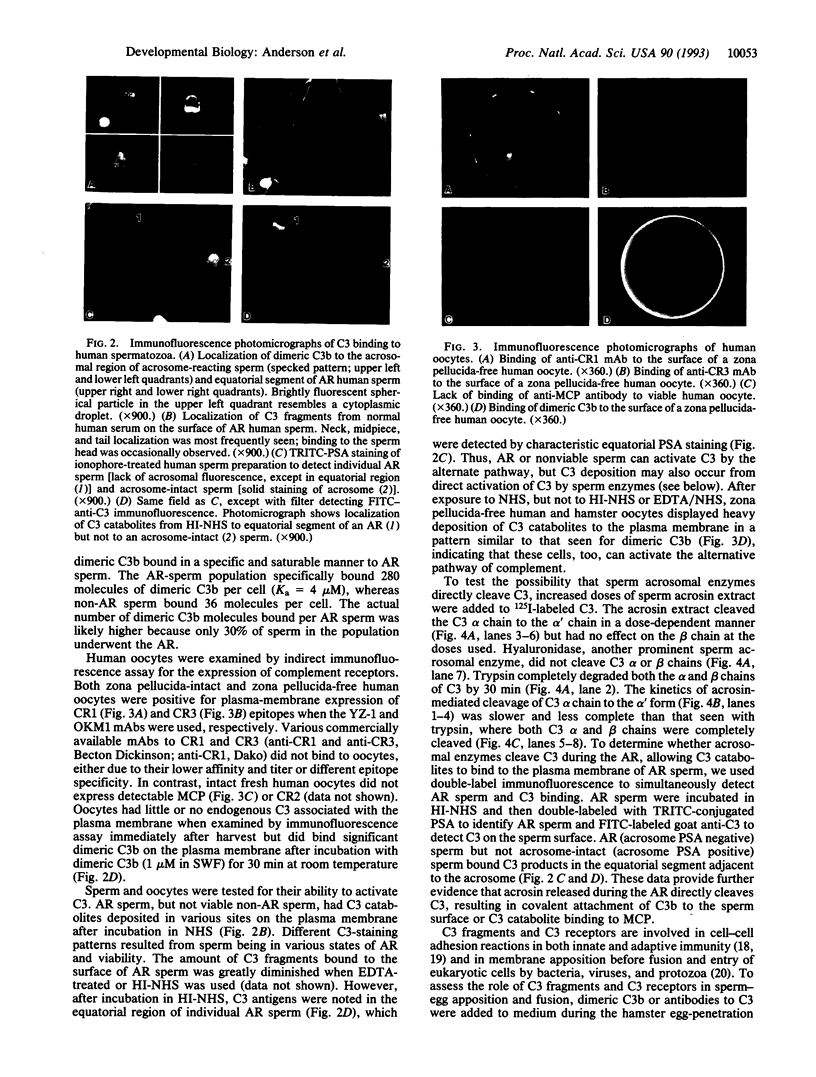
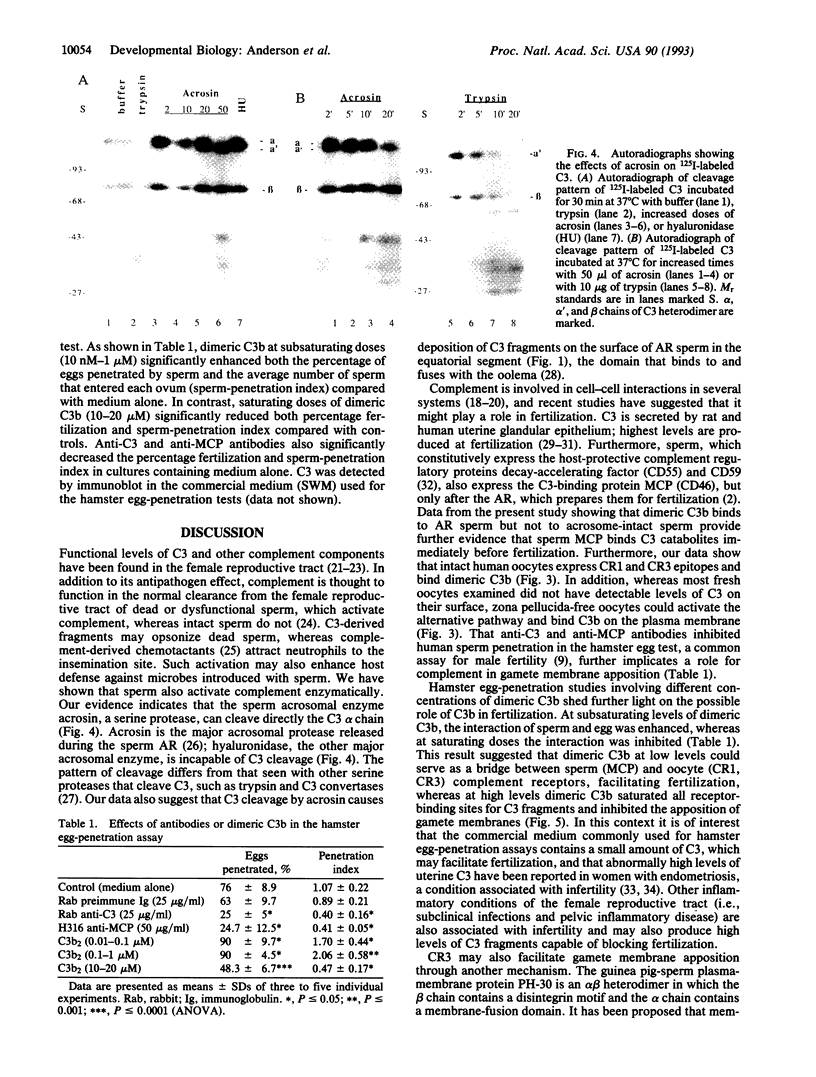
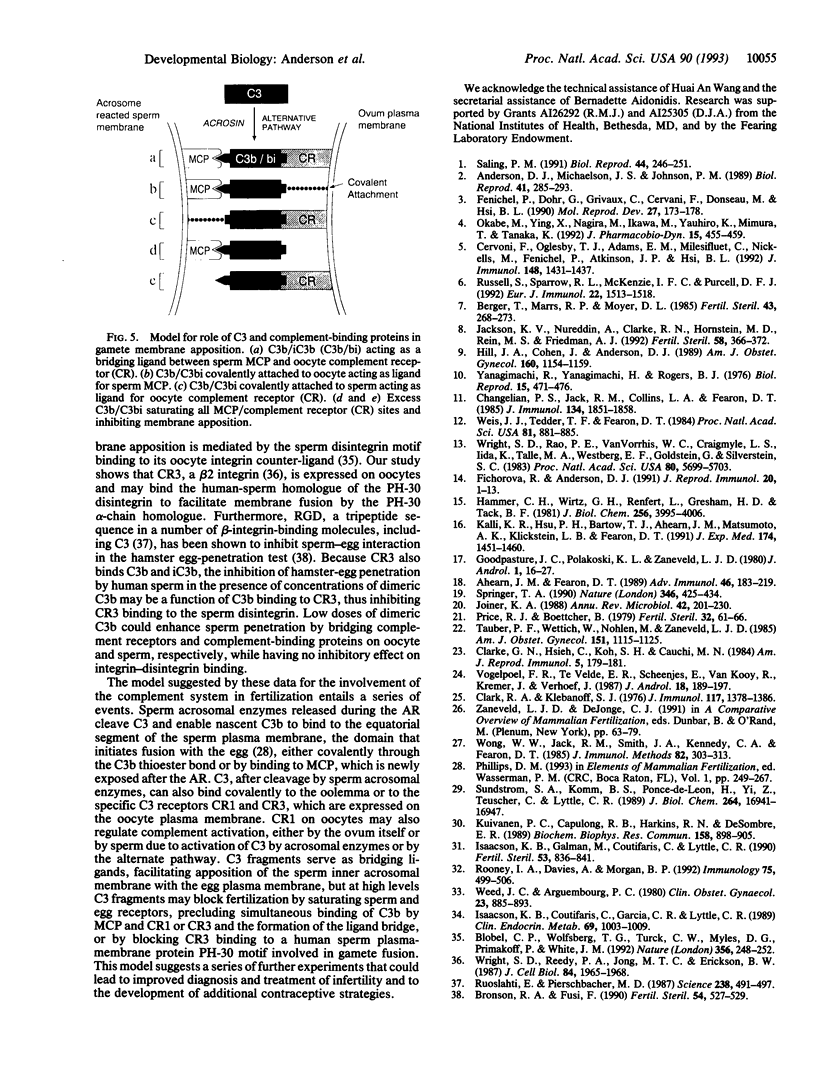
Images in this article
Selected References
These references are in PubMed. This may not be the complete list of references from this article.
- Ahearn J. M., Fearon D. T. Structure and function of the complement receptors, CR1 (CD35) and CR2 (CD21). Adv Immunol. 1989;46:183–219. doi: 10.1016/s0065-2776(08)60654-9. [DOI] [PubMed] [Google Scholar]
- Akasaki M., Jardieu P., Ishizaka K. Immunosuppressive effects of glycosylation inhibiting factor on the IgE and IgG antibody response. J Immunol. 1986 May 1;136(9):3172–3179. [PubMed] [Google Scholar]
- Anderson D. J., Michaelson J. S., Johnson P. M. Trophoblast/leukocyte-common antigen is expressed by human testicular germ cells and appears on the surface of acrosome-reacted sperm. Biol Reprod. 1989 Aug;41(2):285–293. doi: 10.1095/biolreprod41.2.285. [DOI] [PubMed] [Google Scholar]
- Berger T., Marrs R. P., Moyer D. L. Comparison of techniques for selection of motile spermatozoa. Fertil Steril. 1985 Feb;43(2):268–273. [PubMed] [Google Scholar]
- Bronson R. A., Fusi F. Sperm-oolemmal interaction: role of the Arg-Gly-Asp (RGD) adhesion peptide. Fertil Steril. 1990 Sep;54(3):527–529. doi: 10.1016/s0015-0282(16)53775-3. [DOI] [PubMed] [Google Scholar]
- Cervoni F., Oglesby T. J., Adams E. M., Milesifluet C., Nickells M., Fenichel P., Atkinson J. P., Hsi B. L. Identification and characterization of membrane cofactor protein of human spermatozoa. J Immunol. 1992 Mar 1;148(5):1431–1437. [PubMed] [Google Scholar]
- Changelian P. S., Jack R. M., Collins L. A., Fearon D. T. PMA induces the ligand-independent internalization of CR1 on human neutrophils. J Immunol. 1985 Mar;134(3):1851–1858. [PubMed] [Google Scholar]
- Clark R. A., Klebanoff S. J. Generation of a neutrophil chemotactic agent by spermatozoa: role of complement and regulation by seminal plasma factors. J Immunol. 1976 Oct;117(4):1378–1386. [PubMed] [Google Scholar]
- Clarke G. N., Hsieh C., Koh S. H., Cauchi M. N. Sperm antibodies, immunoglobulins, and complement in human follicular fluid. Am J Reprod Immunol. 1984 Jun;5(4):179–181. doi: 10.1111/j.1600-0897.1984.tb00192.x. [DOI] [PubMed] [Google Scholar]
- Fichorova R., Anderson D. J. Use of sperm viability and acrosomal status assays in combination with immunofluorescence technique to ascertain surface expression of sperm antigens. J Reprod Immunol. 1991 May;20(1):1–13. doi: 10.1016/0165-0378(91)90019-m. [DOI] [PubMed] [Google Scholar]
- Fénichel P., Dohr G., Grivaux C., Cervoni F., Donzeau M., Hsi B. L. Localization and characterization of the acrosomal antigen recognized by GB24 on human spermatozoa. Mol Reprod Dev. 1990 Oct;27(2):173–178. doi: 10.1002/mrd.1080270214. [DOI] [PubMed] [Google Scholar]
- Hammer C. H., Wirtz G. H., Renfer L., Gresham H. D., Tack B. F. Large scale isolation of functionally active components of the human complement system. J Biol Chem. 1981 Apr 25;256(8):3995–4006. [PubMed] [Google Scholar]
- Hill J. A., Cohen J., Anderson D. J. The effects of lymphokines and monokines on human sperm fertilizing ability in the zona-free hamster egg penetration test. Am J Obstet Gynecol. 1989 May;160(5 Pt 1):1154–1159. doi: 10.1016/0002-9378(89)90179-8. [DOI] [PubMed] [Google Scholar]
- Hosaka M., Nagahama M., Kim W. S., Watanabe T., Hatsuzawa K., Ikemizu J., Murakami K., Nakayama K. Arg-X-Lys/Arg-Arg motif as a signal for precursor cleavage catalyzed by furin within the constitutive secretory pathway. J Biol Chem. 1991 Jul 5;266(19):12127–12130. [PubMed] [Google Scholar]
- Isaacson K. B., Coutifaris C., Garcia C. R., Lyttle C. R. Production and secretion of complement component 3 by endometriotic tissue. J Clin Endocrinol Metab. 1989 Nov;69(5):1003–1009. doi: 10.1210/jcem-69-5-1003. [DOI] [PubMed] [Google Scholar]
- Isaacson K. B., Galman M., Coutifaris C., Lyttle C. R. Endometrial synthesis and secretion of complement component-3 by patients with and without endometriosis. Fertil Steril. 1990 May;53(5):836–841. [PubMed] [Google Scholar]
- Ishizaka K. Regulation of IgE synthesis. Annu Rev Immunol. 1984;2:159–182. doi: 10.1146/annurev.iy.02.040184.001111. [DOI] [PubMed] [Google Scholar]
- Iwamatsu A., Aoyama H., Dibó G., Tsunasawa S., Sakiyama F. Amino acid sequence of nuclease S1 from Aspergillus oryzae. J Biochem. 1991 Jul;110(1):151–158. doi: 10.1093/oxfordjournals.jbchem.a123534. [DOI] [PubMed] [Google Scholar]
- Iwamatsu A. S-carboxymethylation of proteins transferred onto polyvinylidene difluoride membranes followed by in situ protease digestion and amino acid microsequencing. Electrophoresis. 1992 Mar;13(3):142–147. doi: 10.1002/elps.1150130129. [DOI] [PubMed] [Google Scholar]
- Iwata M., Ishizaka K. Construction of antigen-specific suppressor T cell hybridomas from spleen cells of mice primed for the persistent IgE antibody formation. J Immunol. 1988 Nov 15;141(10):3270–3277. [PubMed] [Google Scholar]
- Jardieu P., Akasaki M., Ishizaka K. Carrier-specific suppression of antibody responses by antigen-specific glycosylation-inhibiting factors. J Immunol. 1987 Mar 1;138(5):1494–1501. [PubMed] [Google Scholar]
- Kalli K. R., Hsu P. H., Bartow T. J., Ahearn J. M., Matsumoto A. K., Klickstein L. B., Fearon D. T. Mapping of the C3b-binding site of CR1 and construction of a (CR1)2-F(ab')2 chimeric complement inhibitor. J Exp Med. 1991 Dec 1;174(6):1451–1460. doi: 10.1084/jem.174.6.1451. [DOI] [PMC free article] [PubMed] [Google Scholar]
- Kozak M. Comparison of initiation of protein synthesis in procaryotes, eucaryotes, and organelles. Microbiol Rev. 1983 Mar;47(1):1–45. doi: 10.1128/mr.47.1.1-45.1983. [DOI] [PMC free article] [PubMed] [Google Scholar]
- Kuivanen P. C., Capulong R. B., Harkins R. N., DeSombre E. R. The estrogen-responsive 110K and 74K rat uterine secretory proteins are structurally related to complement component C3. Biochem Biophys Res Commun. 1989 Feb 15;158(3):898–905. doi: 10.1016/0006-291x(89)92807-6. [DOI] [PubMed] [Google Scholar]
- Laemmli U. K. Cleavage of structural proteins during the assembly of the head of bacteriophage T4. Nature. 1970 Aug 15;227(5259):680–685. doi: 10.1038/227680a0. [DOI] [PubMed] [Google Scholar]
- Lanahan A., Williams J. B., Sanders L. K., Nathans D. Growth factor-induced delayed early response genes. Mol Cell Biol. 1992 Sep;12(9):3919–3929. doi: 10.1128/mcb.12.9.3919. [DOI] [PMC free article] [PubMed] [Google Scholar]
- Liu Y. C., Kawagishi M., Mikayama T., Inagaki Y., Takeuchi T., Ohashi H. Processing of a fusion protein by endoprotease in COS-1 cells for secretion of mature peptide by using a chimeric expression vector. Proc Natl Acad Sci U S A. 1993 Oct 1;90(19):8957–8961. doi: 10.1073/pnas.90.19.8957. [DOI] [PMC free article] [PubMed] [Google Scholar]
- Matsuki S., Ozawa T., Nagao S., Hirata H., Kanoh H., Nozawa Y. High-level expression of complementary DNA encoding rat calmodulin in Escherichia coli. Biotechnol Appl Biochem. 1990 Jun;12(3):284–291. [PubMed] [Google Scholar]
- Nichols B. P., Yanofsky C. Plasmids containing the trp promoters of Escherichia coli and Serratia marcescens and their use in expressing cloned genes. Methods Enzymol. 1983;101:155–164. doi: 10.1016/0076-6879(83)01011-3. [DOI] [PubMed] [Google Scholar]
- Oakley B. R., Kirsch D. R., Morris N. R. A simplified ultrasensitive silver stain for detecting proteins in polyacrylamide gels. Anal Biochem. 1980 Jul 1;105(2):361–363. doi: 10.1016/0003-2697(80)90470-4. [DOI] [PubMed] [Google Scholar]
- Okabe M., Ying X., Nagira M., Ikawa M., Kohama Y., Mimura T., Tanaka K. Homology of an acrosome-reacted sperm-specific antigen to CD46. J Pharmacobiodyn. 1992 Aug;15(8):455–459. doi: 10.1248/bpb1978.15.455. [DOI] [PubMed] [Google Scholar]
- Price R. J., Boettcher B. The presence of complement in human cervical mucus and its possible relevance to infertility in women with complement-dependent sperm-immobilizing antibodies. Fertil Steril. 1979 Jul;32(1):61–66. doi: 10.1016/s0015-0282(16)44117-8. [DOI] [PubMed] [Google Scholar]
- Remold H. G., Mednis A. D. Migration inhibitory factor. Methods Enzymol. 1985;116:379–394. doi: 10.1016/s0076-6879(85)16030-1. [DOI] [PubMed] [Google Scholar]
- Rooney I. A., Davies A., Morgan B. P. Membrane attack complex (MAC)-mediated damage to spermatozoa: protection of the cells by the presence on their membranes of MAC inhibitory proteins. Immunology. 1992 Mar;75(3):499–506. [PMC free article] [PubMed] [Google Scholar]
- Rubartelli A., Cozzolino F., Talio M., Sitia R. A novel secretory pathway for interleukin-1 beta, a protein lacking a signal sequence. EMBO J. 1990 May;9(5):1503–1510. doi: 10.1002/j.1460-2075.1990.tb08268.x. [DOI] [PMC free article] [PubMed] [Google Scholar]
- Ruoslahti E., Pierschbacher M. D. New perspectives in cell adhesion: RGD and integrins. Science. 1987 Oct 23;238(4826):491–497. doi: 10.1126/science.2821619. [DOI] [PubMed] [Google Scholar]
- Russell S. M., Sparrow R. L., McKenzie I. F., Purcell D. F. Tissue-specific and allelic expression of the complement regulator CD46 is controlled by alternative splicing. Eur J Immunol. 1992 Jun;22(6):1513–1518. doi: 10.1002/eji.1830220625. [DOI] [PubMed] [Google Scholar]
- Saling P. M. How the egg regulates sperm function during gamete interaction: facts and fantasies. Biol Reprod. 1991 Feb;44(2):246–251. doi: 10.1095/biolreprod44.2.246. [DOI] [PubMed] [Google Scholar]
- Steele J. K., Kuchroo V. K., Kawasaki H., Jayaraman S., Iwata M., Ishizaka K., Dorf M. E. A monoclonal antibody raised to lipomodulin recognizes T suppressor factors in two independent hapten-specific suppressor networks. J Immunol. 1989 Apr 1;142(7):2213–2220. [PubMed] [Google Scholar]
- Sundstrom S. A., Komm B. S., Ponce-de-Leon H., Yi Z., Teuscher C., Lyttle C. R. Estrogen regulation of tissue-specific expression of complement C3. J Biol Chem. 1989 Oct 5;264(28):16941–16947. [PubMed] [Google Scholar]
- Tagaya Y., Mori A., Ishizaka K. Biochemical characterization of murine glycosylation-inhibiting factor. Proc Natl Acad Sci U S A. 1991 Oct 15;88(20):9117–9121. doi: 10.1073/pnas.88.20.9117. [DOI] [PMC free article] [PubMed] [Google Scholar]
- Takebe Y., Seiki M., Fujisawa J., Hoy P., Yokota K., Arai K., Yoshida M., Arai N. SR alpha promoter: an efficient and versatile mammalian cDNA expression system composed of the simian virus 40 early promoter and the R-U5 segment of human T-cell leukemia virus type 1 long terminal repeat. Mol Cell Biol. 1988 Jan;8(1):466–472. doi: 10.1128/mcb.8.1.466. [DOI] [PMC free article] [PubMed] [Google Scholar]
- Tauber P. F., Wettich W., Nohlen M., Zaneveld L. J. Diffusable proteins of the mucosa of the human cervix, uterus, and fallopian tubes: distribution and variations during the menstrual cycle. Am J Obstet Gynecol. 1985 Apr 15;151(8):1115–1125. doi: 10.1016/0002-9378(85)90394-1. [DOI] [PubMed] [Google Scholar]
- Thomas P., Gomi H., Takeuchi T., Carini C., Tagaya Y., Ishizaka K. Glycosylation-inhibiting factor from human T cell hybridomas constructed from peripheral blood lymphocytes of a bee venom-sensitive allergic patient. J Immunol. 1992 Feb 1;148(3):729–737. [PubMed] [Google Scholar]
- Vogelpoel F. R., te Velde E. R., Scheenjes E., Van Kooy R., Kremer J., Verhoef J. Antibody and complement-binding activity of viable and nonviable human spermatozoa. Arch Androl. 1987;18(3):189–197. doi: 10.3109/01485018708988482. [DOI] [PubMed] [Google Scholar]
- Weed J. C., Arquembourg P. C. Endometriosis: can it produce an autoimmune response resulting in infertility? Clin Obstet Gynecol. 1980 Sep;23(3):885–893. [PubMed] [Google Scholar]
- Weis J. J., Tedder T. F., Fearon D. T. Identification of a 145,000 Mr membrane protein as the C3d receptor (CR2) of human B lymphocytes. Proc Natl Acad Sci U S A. 1984 Feb;81(3):881–885. doi: 10.1073/pnas.81.3.881. [DOI] [PMC free article] [PubMed] [Google Scholar]
- Weiser W. Y., Greineder D. K., Remold H. G., David J. R. Studies on human migration inhibitory factor: characterization of three molecular species. J Immunol. 1981 May;126(5):1958–1962. [PubMed] [Google Scholar]
- Weiser W. Y., Temple P. A., Witek-Giannotti J. S., Remold H. G., Clark S. C., David J. R. Molecular cloning of a cDNA encoding a human macrophage migration inhibitory factor. Proc Natl Acad Sci U S A. 1989 Oct;86(19):7522–7526. doi: 10.1073/pnas.86.19.7522. [DOI] [PMC free article] [PubMed] [Google Scholar]
- Wise R. J., Barr P. J., Wong P. A., Kiefer M. C., Brake A. J., Kaufman R. J. Expression of a human proprotein processing enzyme: correct cleavage of the von Willebrand factor precursor at a paired basic amino acid site. Proc Natl Acad Sci U S A. 1990 Dec;87(23):9378–9382. doi: 10.1073/pnas.87.23.9378. [DOI] [PMC free article] [PubMed] [Google Scholar]
- Wong W. W., Jack R. M., Smith J. A., Kennedy C. A., Fearon D. T. Rapid purification of the human C3b/C4b receptor (CR1) by monoclonal antibody affinity chromatography. J Immunol Methods. 1985 Oct 10;82(2):303–313. doi: 10.1016/0022-1759(85)90362-x. [DOI] [PubMed] [Google Scholar]
- Wright S. D., Rao P. E., Van Voorhis W. C., Craigmyle L. S., Iida K., Talle M. A., Westberg E. F., Goldstein G., Silverstein S. C. Identification of the C3bi receptor of human monocytes and macrophages by using monoclonal antibodies. Proc Natl Acad Sci U S A. 1983 Sep;80(18):5699–5703. doi: 10.1073/pnas.80.18.5699. [DOI] [PMC free article] [PubMed] [Google Scholar]
- Wright S. D., Reddy P. A., Jong M. T., Erickson B. W. C3bi receptor (complement receptor type 3) recognizes a region of complement protein C3 containing the sequence Arg-Gly-Asp. Proc Natl Acad Sci U S A. 1987 Apr;84(7):1965–1968. doi: 10.1073/pnas.84.7.1965. [DOI] [PMC free article] [PubMed] [Google Scholar]
- Yanagimachi R., Yanagimachi H., Rogers B. J. The use of zona-free animal ova as a test-system for the assessment of the fertilizing capacity of human spermatozoa. Biol Reprod. 1976 Nov;15(4):471–476. doi: 10.1095/biolreprod15.4.471. [DOI] [PubMed] [Google Scholar]





